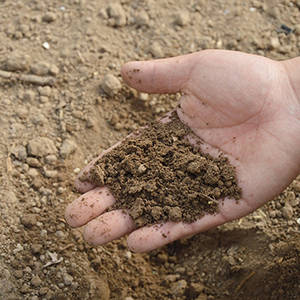
Soil Improvement

Soil amendment
The crop support or "land" is an essential and unavoidable point in the context of reflection and landscaping. Depending on its nature, it will condition the passage of networks, infrastructures, e.g.: constitution of masonry of the terrace, basin, pedestrian or car path type, etc; but also the choice and use of plant species which will be conditioned by the nature of the soil or soils present.
If we speak of a cultural support, it is because this image reflects the fact that the soil will receive and accompany all the elements that make up a landscape project and will influence the choices, the respect of the rules of art and professional rules, as well as the DTU standards. It goes without saying that we have never seen a plant move alone, to replant elsewhere and thus benefit from better growing conditions, more favourable to its species, genus, variety and cultivar.
If we focus on the plant aspect, the crop support or the soil, we will have to consider two aspects:
- I am dealing with, and I am not making, or providing, any major changes, improvements or amendments. I adapt my project to the existing biotope and ecosystem, which does not prevent me from giving free rein to my landscape inspirations and to the contribution of organic matter such as plant compost or natural amendments.
- I decide, or more precisely, I wish to make the crop support or soil accessible to the greatest number of plant species, which is not the case at first sight: presence or not of a relief, different soil strata and profiles, gullying and erosion effect, draining soil or not, nutrient reserve in quantity or presence of deficiencies, etc.
In case 1 :
I will accompany and give plants the possibility to adapt to the soil in place, with solutions to improve reserves and nutrient exchanges. The contribution of plant compost and natural organic amendments will satisfy heavy, intermediate and light soils alike. These organic amendments, and especially plant compost, will have the ability to lighten heavy soils by supplementing their nutrient reserves; to strengthen the nutrient reserves of intermediate soils that are often deficient; and to make light, leached soils heavier, while allowing the retention and creation of nutrient reserves. The same will be true for water, which will be better drained in heavy soils without favouring its too rapid infiltration into the subsoil (out of reach of plant roots) or its evaporation, to increase the retention and availability over time of intermediate soils, and to offer overly draining light soils a capacity to retain and gradually release water and nutrients that were heavily leached before.
The re-establishment of quality air/water exchanges in all seasons, as well as the possibility of offering nutrient and water reserves easily accessible to the roots, with a regular supply of organic matter to recharge the reserves, will participate in the transformation of the land in place and make it tend towards the characteristics of "arable land" quality topsoil, and will allow the plants to take root well, a sign of better resistance to drought, parasitic attacks and the possibility of good production of foliage, flowers and fruit.
This modification and improvement of the land cannot take place without the improvement of the biotope, favourable to the return and multiplication of "earthworms", the only ones capable of making two distinct elements, soil and organic matter, into a single element called "topsoil".
In case 2 :
The landscaped project will probably require plants of different types (genera, species, varieties, etc.) and from different horizons to live together in a restricted environment and sometimes in opposition to each other.
At this stage, we have several options:
- Land ReplacementThe replacement of land by land appropriate to the nature of the selected plants then becomes unavoidable, e.g.: heather land for heather land plants, stony land for plants of medium and high mountain or Mediterranean environment, specific land that can be assembled using several substrates and sometimes under the control of engineering and technical offices or specialised suppliers, particularly in the context of the cultivation of certain perennial plants, shrubs, ground covers, with a preference for highly humiferous, draining, acidic, alkaline, etc. soil.
- Land ImprovementIn the context of the use of multiple plants of different genera, species, varieties and horizons (geographical locations), in a more or less restricted space, soil improvement will become essential. Beforehand, it will be necessary to take into account the effects of slopes, orientations (cardinal points), the existing plant cover in all its forms, from the tallest tree to the smallest plants often considered as weeds but which, as native plants, will give us essential information on the nature of the soil, the areas of shade provided by constructions, wind corridors etc. Once these elements have been taken into account, after selecting the plants desired in the project, we must apply ourselves to respecting a good layering and complementarity of the vegetative strata, working by zone, in order to be able to make soil improvements on similar groups of individuals. Because, as we know, plants have an interaction at the root system level as well as exchanges. Soil improvement will also have to take into account the conservation areas of shaded and sunny parts, or on the contrary, the shading areas created, or the openings to the sunlight. Even improved soils, on one side or the other, will see their biotope evolve and change with an impact on existing or newly implanted plants.
Once again, all these modifications will evolve over time according to the capacity of the soil and therefore of the biotope to integrate these modifications. Earthworms will have an essential role in this process, except for heathland, and it will all depend on climatic conditions, which are very changeable to date, even with the provision of controlled irrigation if necessary.
To help you in this soil improvement work, depending on the surface, access, and your willingness to work, you will have the choice of a range of equipment from the excavator, through the tractor, horses or oxen, micro tractors and other tool carriers of all types and brands, to the tiller and rotary tiller, as well as the whole range of manual tools known as handle tools.
In all cases, the soil or subsoil must not be closed by the creation of a glacis, caused by the repeated passage of an often rotating tool, hammering the soil always at the same depth, e.g. using a tiller without first decompaction of the subsoil and without mixing the strata with a mechanical backhoe, or the use of a spade instead of a spade fork. In any case, the incorporation of the amendments will probably take place on the first 20 to 30 centimetres of soil at most. It is the biotope and the earthworms that will achieve the symbiosis over time, over the first 5 to 10 years, or even 15 years. Thus, over successive rainfalls, the nutrients, after having been made available to the plants, will be dragged deep down and will be able to benefit all the root strata. A reserve will also be available and it will be necessary to measure all of this regularly, in order to estimate the incorporation and establishment of reserves following the various amendments. It would be advisable to do this every 3 to 5 years and, depending on the results, to adjust your working interventions and the introduction of new amendments if necessary.

